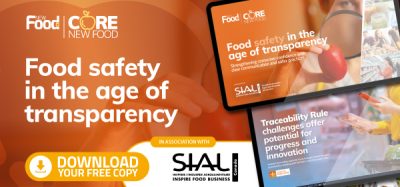A bright outlook for robotics
- Like
- Digg
- Del
- Tumblr
- VKontakte
- Buffer
- Love This
- Odnoklassniki
- Meneame
- Blogger
- Amazon
- Yahoo Mail
- Gmail
- AOL
- Newsvine
- HackerNews
- Evernote
- MySpace
- Mail.ru
- Viadeo
- Line
- Comments
- Yummly
- SMS
- Viber
- Telegram
- Subscribe
- Skype
- Facebook Messenger
- Kakao
- LiveJournal
- Yammer
- Edgar
- Fintel
- Mix
- Instapaper
- Copy Link
Posted: 11 August 2006 | Jonas Westlund, Consulting Analyst, Frost & Sullivan | No comments yet
The European market for material handling robots has grown to approximately $800 million in 2005. More interestingly, forecast growth for 2006 of around 15 per cent shows that robots are playing an increasingly important role in the European food and beverage sector.
The implementation of robots help food processors meet heightened demand on operational efficiency and regulations on health and safety and traceability. Moreover, improvements in vision systems are expected to make robots increasingly important in quality assessment processes. The net result is likely to see material handling robot solutions achieve a year-on-year growth in excess of 16 per cent over the next six years to reach $225 million by 2012.
The European market for material handling robots has grown to approximately $800 million in 2005. More interestingly, forecast growth for 2006 of around 15 per cent shows that robots are playing an increasingly important role in the European food and beverage sector. The implementation of robots help food processors meet heightened demand on operational efficiency and regulations on health and safety and traceability. Moreover, improvements in vision systems are expected to make robots increasingly important in quality assessment processes. The net result is likely to see material handling robot solutions achieve a year-on-year growth in excess of 16 per cent over the next six years to reach $225 million by 2012.
The European market for material handling robots has grown to approximately $800 million in 2005. More interestingly, forecast growth for 2006 of around 15 per cent shows that robots are playing an increasingly important role in the European food and beverage sector.
The implementation of robots help food processors meet heightened demand on operational efficiency and regulations on health and safety and traceability. Moreover, improvements in vision systems are expected to make robots increasingly important in quality assessment processes. The net result is likely to see material handling robot solutions achieve a year-on-year growth in excess of 16 per cent over the next six years to reach $225 million by 2012.
Food and beverage companies have traditionally been reluctant to adopt new technologies for automated solutions. Low-profit margins as a result of intense competition in the retail sector have made food and beverage processing companies more hesitant when planning expensive capital investments. Often, food processors prefer to use existing and often outdated systems, or resort to home-grown technologies. Therefore, suppliers of automation face a considerable challenge in persuading food and beverage companies that their products would make a positive impact on the bottom line.
However, while the food and beverage end-user sector only accounts for less than ten per cent of the total European market for robot material handling, it has now become one of the fastest growing markets. Robot solutions are already widely used in downstream application areas such as packaging and palletising. Although some issues still need to be addressed in the upstream environment, new developments in vision systems are likely to drive increased investment also for pick and place applications in this environment.
Market drivers
With labour costs in Europe steadily increasing, investment in flexible automation has become more economically viable. For example, hourly labour costs in EU-25 increased on average by more than 30% between 1999 and 2003. In contrast, the price of industrial robots relative to labour costs has fallen by 26% during the same period of time and it is not unusual for robots to have a pay-back period as short as 1-2 years.
Health and safety is another important driver for investing in robot solutions. Robots can be used in ‘hostile’ environments and can also replace operations that would be too heavy or strenuous to human labour. Recent food regulations in Europe have also emphasised the importance of traceability throughout the supply chain, and robots can be increasingly used for performing tasks such as bar-code reading of packaged products.
Opportunities in upstream production
Robot applications in the food and beverage sector today are mostly employed in downstream applications such as packaging and palletising. However, the number of opportunities in upstream applications are set to increase. It is accepted that robots can perform operations more cost effectively, precisely and systematically than any other means. With changing manufacturing processes and product design, a robot would be particularly suitable to also handle other – and more demanding – parts of the production process. As the food and beverage sector is increasingly facing increased pressure to adopt a more flexible production approach driven by shorter production cycles, the need for implementing more flexible automated solutions is increasing throughout the production process.
Many food products are designed to appeal to buyers for a short period of time only, which puts immense pressure on food processors and time-to-market. Equally important is product consistency. Retailers can always be certain to get what has been requested when robots have been used for food assembly, which is not necessarily the case when employing people. Moreover, with improvements in vision systems, robots will become increasingly important for quality assessment. Using robots also means that each product can be traced to the robot that handled each individual product. However, there are still challenges to overcome in terms of cleanability and actuator technology before we are able to see a great impact in the upstream sector.
Key challenges
There are a number of other challenges faced by smaller firms when investing in the use of robots. The need for easy-to-use robots is apparent, particularly when considering the lack of experience and expertise in using robots. Compared to other industry sectors such as automotive where the use of robotic systems is well adopted, many food processors face a challenge to develop and retain in-house expertise for handling the robot and being able to identify and solve technical issues when these occur. A common perception amongst small firms is also that economic requirements cannot be met and that robotics systems are programmed for handling large product volumes.
Moreover, although prices for robotic systems have fallen considerably there is still a reluctance to invest because of the initial investment cost. For example, the typical cost of an upstream pick and place robot is approximately £100,000. This would still exclude the cost of the conveyor belt. Although product challenges such as hygienic design, cleanability and actuator technology still remain it is expected that new developments over time will increasingly justify investment decisions, also in the upstream food sector.
Although the market for robot solutions is set to show significant growth in the next few years, there is still a strong need amongst suppliers to educate end-users about the benefits of implementing robotic systems in their production in order to fully exploit this potential. There is still reluctance amongst end-users to adopt robot systems based on limited knowledge of dealing with robots. Furthermore, there is also a perception that complex and costly robot systems could impact on a food firm’s finances. Therefore, there is a strong need for user-friendly robots and improvements could still be made in the fields of programming, operating and in maintaining the robot system.
Outlook
In the longer term, food processors are in a good position to benefit from new robotics technology and from the associated cost-savings. Also, companies with smaller production volumes should benefit from using robots as these firms often have a greater need for flexibility compared to large volume food processors. Heightened competition from low-cost manufacturers, increased demand on operational efficiency together with health and safety regulations will all contribute to a higher uptake of robots in upstream food processing applications over the next few years.







